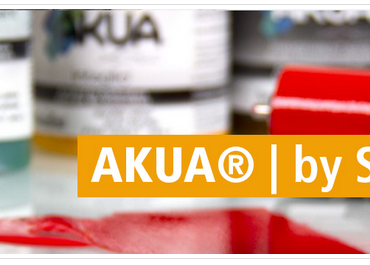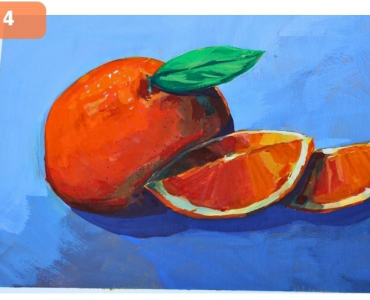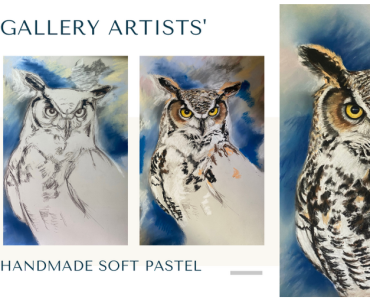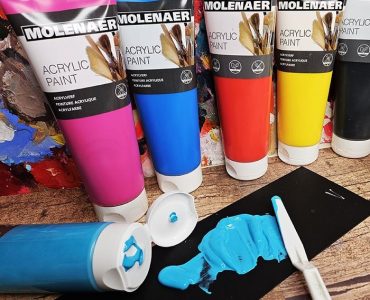This blog post is aimed especially at schools, home educators and all groups who do creative work with young people! This time she’s looking at Artist Junior Acrylics.

Key Features of Artist Junior Acrylic:
- These acrylic paints are available in a wide colour range including metallics and the colours are all completely intermixable, which means you can make an almost limitless number of colour variations.
- All dry bright and with a waterproof finish.
- They come in practical plastic bottles with screw tops and Jo particularly likes the dispenser nozzle which avoids waste
- They conform to toy standard EN 71-3 and thus ensure the safety of children during painting, making it particularly suitable for use in school and education.
Why all Schools should buy acrylics!
A brilliant, cost effective and incredibly useful material for school use, because:
- They are safe for use in primary and secondary schools, although obviously very young children should be carefully supervised when using them.
- The fact that they dry so fast is great when working with children and young people-waiting times are reduced so there is much less frustration and hanging around and this also means that work is much less prone to smudging or other damage.
- Acrylics can be used on almost any surface apart from waxy or greasy ones. This means that they are perfect for painting directly onto paper, card (even brown packaging card), fabric, wood, metal, and leather. Acrylics are great for adding colour to card models, pieces made from both traditional and air-hardening clay and mod roc models too.
- They are also perfect for large scale work such as backdrops for school productions, and even for outside pieces.
- Acrylics are a really high quality medium that allows children to produce excellent work in a range of techniques and approaches including with painting knives, and traditional brush techniques.

Making a Start
Jo began by putting out some colour and getting the feel for how it works: The paint has a nice creamy thick consistency and is naturally quite glossy. The colours are rich and vibrant, and mix beautifully. They would be ideal for encouraging young artists to develop their skills in both handling paint and also mixing colour.

With acrylic paint you can mix colour on your palette, but you can also blend colour directly on your work. The image above, shows Jo’s completed experiment sheet which combines a range of different techniques made using silicone blades, palette knives, and even glue spreaders and brush handles: I have to say I was super impressed with the vibrancy of the colour, and quality of finish!
Painting colour on black paper is always a good test of the quality of pigments used. Here Jo’s applied colour with a flat brush, quite thinly and with overlaying marks: I really like the luminous effect it made, even on very dark paper as a ground.
Printing with Gelli Plates
Artist Junior Acrylics are also ideal for printing using Gelli Plates. These are blocks of clear, totally safe material which is amazingly sensitive to delicate marks and textures, but you must not use anything pointed or sharp as the block will retain the image permanently.

Here you can see an ideal set up for printing with gel plates. The plate is placed onto a sheet of acetate on top of clean newsprint. The workspace is organised with paper cut to size, a clean roller and also a spray bottle with clean water for cleaning up. Make sure you also have plenty of paper towels to hand.
Ink up your Gelli plate with a thin coat of acrylic using a roller as shown. Dot small blobs of colour on the plate, and allow colours to mix or stay separate, depending on the effect you want

You can see that I’ve created a design in the acrylic paint using the white silicone wedge shown. But you can simply add stencils or press in textures to create really exciting effects. To transfer the print, simply cover your block with pre-cut paper, and then rub down lightly with your hand or a clean roller, then peel off gently and put to dry for a minute or so ready to add the next layer.
Try printing on a range of different types and colours of paper, but remember thin is good at least to begin with as it is easy to see whether you have transferred your image successfully.
Painting on Fabric
These acrylics also work brilliantly for painting directly on fabric, which allows you to create large scale pieces like hangings, banners and backdrops.
In the Artist Junior range you can also find a textile medium which can be used to mix roughly 50:50 with the acrylics, and this maintains the softness of the fabric. However, I found it worked really well on fabric with or without the medium, so if it isn’t something where softness is important, it isn’t strictly necessary. Either way colours can be fixed by ironing on the REVERSE of the fabric when you have completed the piece.

Have a design drawn out on paper using a bold pencil or ink for clarity, and lay it under a sheet of fabric as shown. The sheet of acetate under the fabric is important as a sheet of paper underneath will stick.

Place your fabric on top and transfer the design in soft pencil. When you’ve transferred the design remove the sheet of paper, leaving the fabric on its acetate sheet, ready for painting.
Tape the fabric down and paint with a soft brush. Add a little water or textile medium to help the paint flow on the fabric.
Jo’s Top Tips
- Cover work surfaces with wipeable covers or newspaper.
- Wear aprons or old shirts to protect clothes.
- Ideally use acrylics undiluted or with only tiny amounts of water-this gives optimum results and also reduces mess!
- Have a bowl of soapy water ready and put brushes in as soon as they have finished being used-if left acrylics dry HARD! They will sit happily like this until there’s time to clean them properly-wash thoroughly with washing up liquid and warm water, rinse throughly, reshape bristles and allow to dry with bristles pointing upwards in a pot.
- Other painting tools like plastic palette knives and silicone blades and wedges can simply be wiped with a paper towel as needed and then be washed in the same soapy water at the end of the painting session.
- Paper plates are great for avoiding washing up-scrape back any reusable paint and then simply throw away.
- If you need to save paint for a short time, for example until returning to work after a short break, cover carefully with cling film, but bear in mind this is only a very short term measure.
- Buy at least double the amount of white paint as any other colour as you will go through it faster, and use black as sparingly as possible to maintain clean fresh colour mixes.

To read the full blog post and see Jo’s creative projects, and materials list visit: www.joyorkart.co.uk
All images are © Jo York www.joyorkart.co.uk
Find all Jo’s posts published in GreatArt online Magazine by clicking here!
Discover Artist Junior full range available online at www.greatart.co.uk/artist-junior and in-store.
GreatArt – your art superstore
Art supplies, ideas and advice for all techniques.
GreatArt offers you art supplies for all techniques from:
- traditional fine art painting,
- drawing,
- sculpture,
- printmaking,
- graphic art,
- illustration,
- airbrushing,
- model making…
We offer an extensive range of stretched canvas and display products for exhibition, all the art supplies required to create your own bespoke canvases, as well as custom framing and mounting services from GreatArt Store. You’ll also find hundreds of articles and tutorials to browse in the online magazine.





















the detail of saving paint could be enhanced with an idea that I use.
1 use a plastic lidded box; magarine or food fridge box.
2 Buy some thin sponge wipes from supermarket. cut a piece to fit in the box. cut a piece of clear plastic bag to also fit the box.
3 soak the sponge and allow excess water to drain out.
4 Use the box as the palette and put the lid on when finished painting or in between colours.
5 the paint will last for days if not weeks in the lidded box. It might go a bit mouldy if not used for a long time. to stop this use a small amount of the stuff used for sterilising babies milk bottles. I think it’s called MILTON, on the sponge water.
Happy Painting.